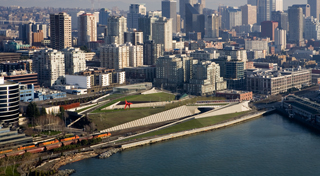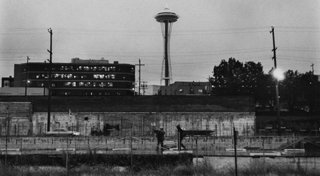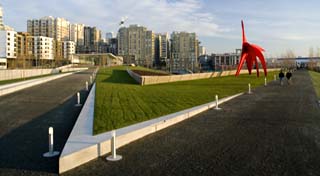 Seattle is quite different from Brooklyn, but citizens there have confronted similar challenges—whether to invest public money in a sports arena, and how best to guide growth—and come up with some interesting and instructive answers, like the new sculpture park depicted at right, an oasis in the midst of development.
Seattle is quite different from Brooklyn, but citizens there have confronted similar challenges—whether to invest public money in a sports arena, and how best to guide growth—and come up with some interesting and instructive answers, like the new sculpture park depicted at right, an oasis in the midst of development. (Photo from Seattle Art Museum)
The Seattle experience may not be directly applicable to the Atlantic Yards controversy, but it does suggest that civic debate—which was short-circuited in Brooklyn when the city/state political establishment backed AY from the gate—can produce alternatives.
Arena subsidies?
First, as I’ve noted, a community group called Citizens for More Important Things got a ballot measure passed last year that ensured that any public money toward a new arena would have to generate legitimate financial returns.
That’s served as a brake on the owners of the Seattle SuperSonics, who are now seeking $300 million in public funds for a new arena in the metro area outside the city. (That arena likely would not be a standalone like the current Key Arena but more of a mixed-use complex.)
Note that the AY project would get $200 million in direct subsidies but much more in tax breaks, public spending, and access to below-market city streets. The amount of subsidies for the affordable housing has not been publicly revealed.
New sculpture park
 My visit to Seattle last week coincided with the opening of the Olympic Sculpture park, a dramatic and arresting addition to the cityscape and waterfront. The park occupies a complicated 9-acre site in the northern section of Belltown, the booming neighborhood, formerly an industrial/warehouse district, just north of the center city, along the mostly-developed waterfront.
My visit to Seattle last week coincided with the opening of the Olympic Sculpture park, a dramatic and arresting addition to the cityscape and waterfront. The park occupies a complicated 9-acre site in the northern section of Belltown, the booming neighborhood, formerly an industrial/warehouse district, just north of the center city, along the mostly-developed waterfront.(Photo from New York Times)
Echoes of Atlantic Yards were inevitable. The site is just about the same size as the Metropolitan Transportation Authority’s Vanderbilt Yard, the main component of the planned 22-acre AY development. The Seattle site, formerly an oil transfer and distribution facility, required an expensive clean-up (as does the Brooklyn railyard).
The Seattle site, bisected by a busy (though not commercial) four-lane road and bordered by another road and a rail line, required some complicated bridging. Even greater challenges abound in Brooklyn, where a platform must be built to support construction. At least builders in Brooklyn wouldn’t have a site sloping downhill, as in Seattle.
 Brooklyn’s Vanderbilt Yard is more than a century old; the Seattle site, established by UNOCAL (Union Oil Company of California), dates back to 1910. UNOCAL closed the site in 1975, leaving ugly empty lots—an eyesore, certainly blighted (at least under New York’s loose standards)--and later spent a decade on cleanup efforts. The time wasn’t right for development.
Brooklyn’s Vanderbilt Yard is more than a century old; the Seattle site, established by UNOCAL (Union Oil Company of California), dates back to 1910. UNOCAL closed the site in 1975, leaving ugly empty lots—an eyesore, certainly blighted (at least under New York’s loose standards)--and later spent a decade on cleanup efforts. The time wasn’t right for development.(Photo from Seattle Art Museum)
Building boom
In the late 1990s, as a building boom spread to Belltown, developers hatched a plan to build condos. As the New York Times reported, UNOCAL was sympathetic to the idea of turning the site into a green space—the city is environmentally conscious--so when museum officials approached the company, they were given six months to raise $17 million. (SAM hired a staffer from the Trust for Public Land for the project.) Philanthropists offered $5 million and said they’d give another $20 million for free access if SAM raised the rest of the money.
Indeed, the museum raised $173 million of a $180 million capital campaign, fully funding the $85-million sculpture park. Grants from the federal government, King County and the City of Seattle helped both add slightly to the cite and provide $21 million for toxic waste cleanup and salmon restoration. More than 52 designers competed for the commission, with Weiss/Manfredi Architects of New York selected. (Remember, there was no competition for the Atlantic Yards project.)
Zigzag site
Construction began in 2005, and the park opened on January 20. The park occupies a zigzag site—three connected parcels of land--sloping down the hill to Elliott Bay. The sculptures are striking—a cluster of five 14-foot high Richard Serra steel slabs called "Wake," a playful 19-foot tall "Typewriter Eraser, Scale X," by Claes Oldenburg and Coosje van Bruggen, and Alexander Calder’s 39-foot-tall "Eagle" (below, right).
 Is it frivolous? Actually, the park has stimulated a construction boom. While in one direction, the park offers stunning views of the bay and the distant mountains, in the other three, cranes and new construction are visible. Condos are going up—eight, 12, 15 stories. (Taller buildings are in the center city.) Real estate folk now call this “the Park District.”
Is it frivolous? Actually, the park has stimulated a construction boom. While in one direction, the park offers stunning views of the bay and the distant mountains, in the other three, cranes and new construction are visible. Condos are going up—eight, 12, 15 stories. (Taller buildings are in the center city.) Real estate folk now call this “the Park District.”(Photo from Seattle Times)
The amount of open space is only a bit more than the eight acres promised for the AY site, but the latter would be shrouded by tall buildings, and the 15,000 immediate residents would get first dibs.
The Vanderbilt Yard couldn’t be a sculpture park—its value is easily tenfold that of the Seattle site, and the railyard functions are costly to relocate. New York faces population pressure and density does belong near a transit hub. But the Seattle example shows that “blight” or underdevelopment can be cleared up by strategic public investment.
Transformational project
 Seattle Post-Intelligencer architecture columnist Lawrence W. Cheek called the park “a gloriously rewarding intersection of art, architecture, urbanity and nature” and declared it “the best public space in Seattle,” with the architects triumphing over the “outrageous difficulties of the 9-acre site - a 40-foot slope plus a four-lane road and train track punching through it.”
Seattle Post-Intelligencer architecture columnist Lawrence W. Cheek called the park “a gloriously rewarding intersection of art, architecture, urbanity and nature” and declared it “the best public space in Seattle,” with the architects triumphing over the “outrageous difficulties of the 9-acre site - a 40-foot slope plus a four-lane road and train track punching through it.”(Photo from Seattle Post-Intelligencer)
Sheila Farr, the Seattle Times art critic, suggested that the park opening was transformational moment for the city, just as in the early 1960s the Space Needle arose as part of the nearby Seattle Center. That complex, by the way, now includes the doomed Key Arena and the much-criticized blob that is the Experience Music Project, designed by Frank Gehry. (It’s an entertaining museum, but the building has no context--not that it's supposed to.)
"That area might have developed very differently, have turned into condo and retail space and not the wide-open panorama it now provides," Councilman Peter Steinbrueck, an architect, told Farr: "It's next to [Belltown] the state's fastest growing and densest area, denser even than Capitol Hill, and it's going to continue. [The park] will spur new economic development in the area, which will be positive."
Density issues
 For all its environmental virtues, Seattle has long lacked public open space in and around downtown. So this serves as a crucial corrective, and a reminder of balanced growth. In a Seattle Post-Intelligencer op-ed, Seattle Art Museum director Mimi Gates (wife of Bill, Sr.), director of the Seattle Art Museum, and Gene Duvernoy, president of the Cascade Land Conservancy, wrote:
For all its environmental virtues, Seattle has long lacked public open space in and around downtown. So this serves as a crucial corrective, and a reminder of balanced growth. In a Seattle Post-Intelligencer op-ed, Seattle Art Museum director Mimi Gates (wife of Bill, Sr.), director of the Seattle Art Museum, and Gene Duvernoy, president of the Cascade Land Conservancy, wrote:…If we cannot find comfort in a monumental work of art such as Teresita Fernandez's 220-foot colorful glass trellis along the bridge over the railroad tracks that captures incredible views of the Seattle skyline amid the green of a major sculpture park, our cities will be hollow places, as colorless as the thin sunshine of a winter's day.
This all comes together around the recent debates on building heights downtown, really a debate about that word we all dislike - density. That word is often the problem - it is algebraic, dealing with such and such per-square something or other and avoids the critical question of how we live together. It's a two-way street. Density can bring good things to urban neighborhoods but good things need to be explicitly provided to neighborhoods to make density a good thing.
(Emphasis added)
(Photo from Seattle Art Museum)
Indeed, that’s the debate we haven’t had in Brooklyn. “Growth is good, but growth has its limits,” City Council Member Letitia James said simply but gravely at the 8/23/06 Atlantic Yards public hearing, as captured in the documentary “Brooklyn Matters.” And shortly after that sentence, as James began talking about asthma that the new development would likely increase, she got booed.
Because the state overrides local zoning, we haven’t had a debate about what size and kind of development should go there. Rather, city and state officials essentially let the developer decide. And the decision to include some measure of affordable housing—funded by the public, of course--gives politicians a reason to support something out of scale. The density of Atlantic Yards, I’ve argued, was a privately-negotiated affordable housing bonus.
Learning from Pike Place
 There’s another lesson for Brooklyn—heck, for all urbanists—in the heart of Seattle. Everybody knows the Pike Place Market at the downtown waterfront—it’s a tourist attraction (10 million visitors a year) and a working market, scruffy but busy, with genuinely local, independent restaurants, fishmongers, fruit sellers, craftspersons, and purveyors of goods. The first Starbucks opened there. (Photo from here.)
There’s another lesson for Brooklyn—heck, for all urbanists—in the heart of Seattle. Everybody knows the Pike Place Market at the downtown waterfront—it’s a tourist attraction (10 million visitors a year) and a working market, scruffy but busy, with genuinely local, independent restaurants, fishmongers, fruit sellers, craftspersons, and purveyors of goods. The first Starbucks opened there. (Photo from here.)While the market’s official history leaps between the 1907 establishment of a public street market to connect farmers with consumers and its success a century later, the nine-acre market barely survived some lean years. According to the 1989 book Downtown, Inc., by Bernard Frieden and Lynne Sagalyn, by the 1950s, the market was on its last legs, and the arcade buildings were almost collapsing. Downtown business leaders wanted to put up offices, apartment towers, and hotels. (The Project for Public Spaces, which praised the market, notes that it was deemed "blighted.")
An architecture professor named Victor Steinbrueck (father of the abovenamed councilman) led a citizen effort for a voter initiative to save the market, which passed by a 60 percent vote in 1971. “It was an abrupt repudiation of the business coalition’s goal of a thoroughly modern city center dedicated to economic development,” Frieden and Sagalyn write.
Mayor Wes Uhlman, who’d previously helped save Pioneer Square—just below downtown—from the establishment of office towers, was sympathetic. ("I wanted to save it because it was human scale," he said of Pioneer Square.)
It wasn’t easy to renovate the market. A manager had to find tenants that would satisfy the newly-established Historical Commission and had to generate significant aid to subsidize the merchanges. The city funded most of the project with $40 million in federal money—just as Robert Moses did in his most of his projects in New York.
The preservationist mindset, according to the book, led to conflicts over security, as the market bordered Seattle’s sleaze district. Just three years ago, on my previous visit, the blocks nearby had several sketchy businesses. Now most are gone, a testament to Seattle's steady growth.
Alternatives
Sure, the market is a product of its time and place, and such federal subsidies are no longer available on that scale. Still, it’s remarkable how an alternative vision, based on the wisdom of a community, could prove enormously successful.
Comments
Post a Comment